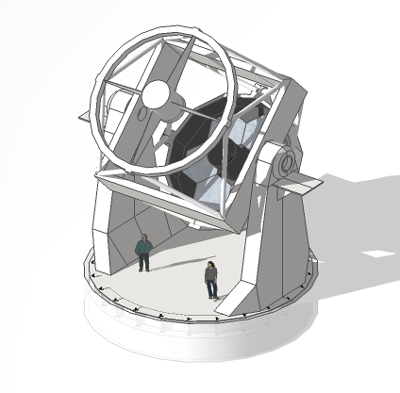Adapted from a story that appeared on the LJMU News site on 4 April 2016. That story also received coverage on BBC Online.
LJMU Vice-Chancellor, Prof Nigel Weatherill and the Director of the Instituto de Astrofisica de Canarias (IAC) Prof Rafael Rebolo López have signed a Memorandum of Understanding to explore the design, construction and operation of the new 4.0 metre telescope which will be on a bigger scale than the current Liverpool Telescope (LT) which has been studying the cosmos and making discoveries for over a decade.
The new telescope will be built on the Spanish Canary Island of La Palma and will be 4 times more sensitive and 10 times faster to respond to unexpected celestial events than the current world-record-holding 2-metre LT, also based on La Palma.
The new optical telescope will have the capability to see deeper into the cosmos, observe exploding stars (supernovae, gamma ray bursts, exoplanets and binary stars) and search for new planets, enabling a different type of science. This kind of study (time-domain astrophysics) will greatly increase in the coming decades, therefore the development of the new 4-metre class facility is vital in being able to explore the Universe in greater detail than ever before.
As well as being scientifically world-leading, the design and construction of the new telescope will exploit new technologies in advanced materials, optics and control systems. Researchers are keen for businesses in the region to provide that technology.
The project is also very exciting for the National Schools’ Observatory, which currently gives school children free access to the LT, and will expand to make use of the new telescope, creating an unrivalled opportunity to enthuse a generation of children about science, technology, engineering and mathematics.
Professor Iain Steele from LJMU's Astrophysics Research Institute (ARI) said: "The timing of this agreement is perfect. With new international discovery facilities like the LIGO and Virgo gravitational wave detectors and the Large Synoptic Survey Telescope coming on line over the next decade, a new high sensitivity spectroscopic capability is desperately needed. The new telescope will fill that niche perfectly”.
Professor Chris Collins, Head of the ARI, added: “This is a major opportunity to greatly expand the excellent science currently carried out by the Liverpool Telescope to cosmological distances. Investigating the exotic physics which govern many distant ultra-energetic sources using data from a large and fast reacting new 4m robotic telescope will keep us busy for many years to come.”
Dr Johan Knapen, IAC, commented: "The project builds on the hugely successful collaboration between LJMU and the IAC in building and operating the LT, which has been making discoveries for a decade. We look forward to working closely with LJMU in this project, which is of the highest calibre both technologically and scientifically."
Professor Rafael Rebolo López, IAC, said: "The new telescope will identify hundreds of exceptional astronomical sources each year, from binary black holes and supernovas, to counterparts of gravitational waves sources. By linking the new telescopes observations with those we can make with the Gran Telescopio Canarias we will be able to characterize these new sources in great detail. Both telescopes complement each other very well.”
Prof Ahmed Al-Shamma'a, Dean of the LJMU Faculty of Engineering and Technology said: "The combination of expertise of LJMU's Faculty of Engineering and Technology and the IAC's leading role as a technology development centre for astronomy puts in a unique position to deliver the technology needed for the project. The new telescope is now in the initial design phase and will be of interest to research centres, universities and companies that want to stand out in a technology sector that will have a major development in the coming decades.”



